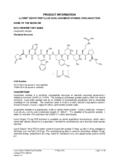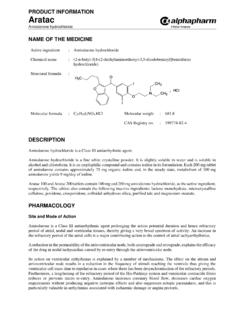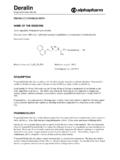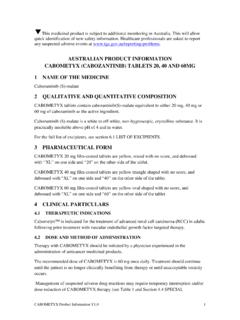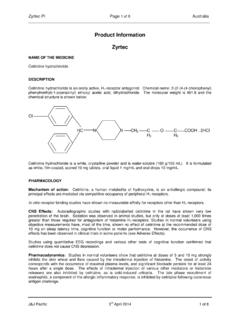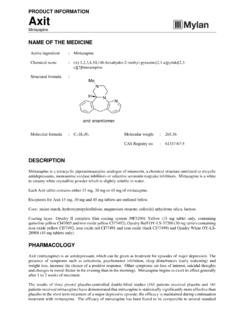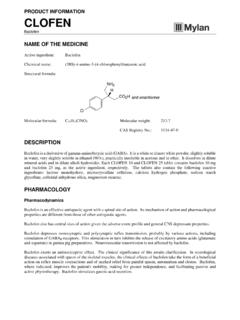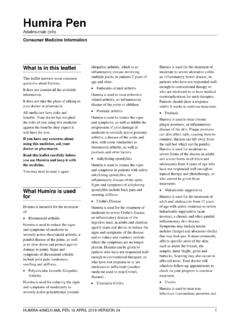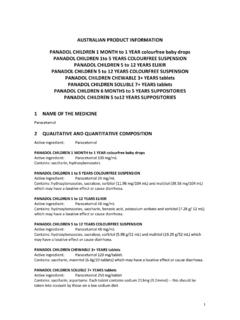Transcription of ELEVA - Medicines
1 AUSTRALIAN PRODUCT INFORMATION ELEVA sertraline hydrochloride 1 NAME OF THE MEDICINE Active ingredient: sertraline hydrochloride 2 QUALITATIVE AND QUANTITATIVE COMPOSITION ELEVA is an antidepressant for oral administration. Each 50 mg tablet contains sertraline hydrochloride equivalent to 50 mg sertraline. Each 100 mg tablet contains sertraline hydrochloride equivalent to 100 mg sertraline. For the full list of excipients, see Section List of excipients. 3 PHARMACEUTICAL FORM ELEVA 50 tablets are white to off-white, capsule shaped, film-coated tablets with ST over score line 50 on one side and G on the other side. ELEVA 100 tablets are white to off-white, capsule shaped, film-coated tablets with ST over score line 100 on one side and G on the other side. 4 CLINICAL PARTICULARS THERAPEUTIC INDICATIONS Children and Adolescents ELEVA is indicated for the treatment of children (aged 6 years of age and older) and adolescents with OCD. Adults ELEVA is indicated for the treatment of major depression, obsessive compulsive disorder (OCD) and panic disorder.
2 ELEVA is indicated for the treatment of social phobia (social anxiety disorder) and the prevention of its relapse. ELEVA is indicated for the treatment of premenstrual dysphoric disorder (PMDD) as defined by DSM-IV criteria. DOSE AND METHOD OF ADMINISTRATION Children and adolescents (6 18 years) Obsessive Compulsive Disorder The administration of ELEVA in children with OCD (ages 6 to 12 years) is recommended to commence at 25 mg/day (half a 50 mg tablet) for the first week and then increasing to 50 mg/day. Adolescents (ages 13 to 18 years) may commence at 50 mg/day. Clinical effects may be noted after 2 weeks of treatment but clinical responses should be monitored for 6 weeks before any increase in dose. In children, a dose of 200 mg/day should not be exceeded. Sertraline has an elimination half-life of approximately 26 hours; a once daily dose in the morning is recommended. Adults (18 years and older) Major Depression/Obsessive Compulsive Disorder Initial Treatment: ELEVA treatment should be initiated with a dose of 50 mg once daily.
3 The usual therapeutic dose for depression and OCD is 50 mg/day. While a relationship between dose and antidepressant and anti- ELEVA PRODUCT INFORMATION 2 obsessive effect has not been established, patients were dosed in a range of 50 to 200 mg/day in the clinical trials demonstrating the anti-depressive and anti-obsessive effectiveness of sertraline. Consequently, patients not responding to a 50 mg/day dose may benefit from dose increases up to a maximum of 200 mg/day. Given the 24 hour elimination half-life of sertraline, dose changes should not occur at intervals of less than 1 week. The onset of therapeutic effect may be seen within 7 days; however for full activity 2 to 4 weeks are usually necessary for depression, and possibly even longer for OCD. Following initial response, sertraline has been associated with sustained efficacy, safety and tolerability in up to 2 years of treatment of OCD. If no effect is apparent after six to eight weeks, discontinuation of treatment should be considered.
4 Studies of efficacy did not examine the role of psychotherapy. Panic Disorder Initial treatment: therapy for panic disorder should commence at 25 mg/day, increasing to 50 mg/day after one week. This dosage regimen has been demonstrated to reduce the frequency of early treatment-emergent side effects commonly experienced on initiation of treatment of panic disorder. The long-term efficacy of sertraline in panic disorder has not been established. Social Phobia (Social Anxiety Disorder) Initial treatment: therapy for social phobia (social anxiety disorder) should commence at 25 mg/day, increasing to 50 mg/day after one week. Premenstrual Dysphoric Disorder Sertraline treatment should be initiated with a dose of 50 mg/day either continuously (every day of the menstrual cycle) or intermittently (by starting 14 days prior to the anticipated onset of menstruation through to the first full day of menses and repeating with each cycle), depending on physician assessment.
5 Patients not responding to a 50 mg/day dose may benefit from dose increases (at 50 mg increments/menstrual cycle) up to 150 mg/day when dosing daily throughout the menstrual cycle, or 100 mg/day when dosing during the luteal phase of the menstrual cycle. If a 100 mg/day dose has been established with luteal phase dosing, a 50 mg/day titration step for three days should be utilised at the beginning of each luteal phase dosing period. Dosage adjustments, which may include changes between dosage regimens ( daily throughout the menstrual cycle versus during the luteal phase of the menstrual cycle), may be needed to maintain the patient on the lowest effective dosage and patients should be periodically reassessed to determine the need for continued treatment. Maintenance/Continuation/Extended Treatment There is evidence to suggest that depressed patients responding during an initial 8 week treatment phase will continue to benefit during an additional 16 weeks of treatment.
6 While there are insufficient data regarding benefits from treatment beyond 24 weeks, it is generally agreed among expert psychopharmacologists that acute episodes of depression require several months or longer of sustained pharmacological therapy. Whether the dose of antidepressant needed to induce remission is identical to the dose needed to maintain and/or sustain euthymia is unknown. Discontinuation should be accomplished by a gradual reduction in dosage. General The daily dose for all indications may be increased in 50 mg increments over a period of weeks. However, dose titrations in 50 mg increments will depend on tolerability and clinical response. The interval between dose increments should be at least one week. The maximum recommended dose of sertraline is 200 mg/day. The onset of therapeutic effect may be seen after a week, however, most responders can be expected to show a good response within 2 to 4 weeks. ELEVA PRODUCT INFORMATION 3 During prolonged maintenance therapy for any indication, dosage should be kept at the lowest effective level.
7 ELEVA should be administered once daily, either in the morning or evening. ELEVA may be administered with or without food. As indicated under section , particular care should be taken in patients with hepatic and/or renal impairment. Use in the elderly requires no special precautions. The usual adult dosage is recommended. CONTRAINDICATIONS ELEVA is contraindicated in patients with a known hypersensitivity to sertraline or any of the tablet excipients. Concomitant use in patients taking pimozide is contraindicated (see section Interactions with Other Medicines and Other Forms of Interaction). Monoamine Oxidase Inhibitors (MAOI): Cases of serious reactions, sometimes fatal, have been reported in patients receiving sertraline in combination with a monoamine oxidase inhibitor (MAOI), including the selective MAOI selegiline, the reversible MAOI (reversible inhibitor of monoamine oxidase RIMA), moclobemide, and MAOI drugs, , linezolid (an antibiotic that is a reversible non-selective MAOI) and methylene blue.
8 Some cases presented with features resembling the serotonin syndrome. Similar cases, sometimes fatal, including hyperthermia, rigidity, myoclonus, autonomic instability with possible rapid fluctuations of vital signs, and mental status changes that include confusion, irritability and extreme agitation progressing to delirium and coma have been reported with other antidepressants during combined treatment with a MAOI and in patients who have recently discontinued an antidepressant or an anti-obsessional drug and have been started on a MAOI. Sertraline should not be used in combination with a MAOI, or within 14 days of discontinuing treatment with a MAOI. Similarly, at least 14 days should be allowed after stopping sertraline before starting a MAOI. SPECIAL WARNINGS AND PRECAUTIONS FOR USE Serotonin Syndrome or Neuroleptic Malignant Syndrome The development of potentially life-threatening syndromes like serotonin syndrome (SS) or neuroleptic malignant syndrome (NMS) has been reported with selective serotonin reuptake inhibitors (SSRIs), including treatment with sertraline.
9 The risk of SS or NMS with SSRIs is increased with concomitant use of serotonergic drugs (including amphetamines, triptans and fentanyl), with drugs that impair metabolism of serotonin (including MAOIs), antipsychotics and other dopamine antagonists. SS symptoms may include mental status changes ( , agitation, hallucinations, coma), autonomic instability ( , tachycardia, labile blood pressure, hyperthermia), neuromuscular aberrations ( , hyperreflexia, incoordination) and/or gastrointestinal symptoms ( , nausea, vomiting, diarrhoea). Some signs of SS, including hyperthermia, muscle rigidity, autonomic instability with possible rapid fluctuation of vital signs, and mental status changes resemble NMS. Patients should be monitored for the emergence of signs and symptoms of SS or NMS syndrome (see section Contraindications). Other Serotonergic Drugs: Co-administration of SSRIs such as sertraline with other drugs that enhance the effects of serotonergic neurotransmission, such as amphetamines, tryptophan, phentermine, fentanyl and its analogues, tramadol, 5-HT agonists, dextromethorphan, tapentadol, pethidine or methadone should be undertaken only with caution and avoided whenever possible due to the potential for pharmacodynamic interaction.
10 St John s Wort: Concomitant use of the herbal remedy St John s Wort (Hypericum perforatum) in patients receiving SSRIs should be avoided since there is a possibility of serotonergic potentiation. ELEVA PRODUCT INFORMATION 4 Switching from Other Antidepressants or Anti-obsessional Drugs There is limited controlled experience regarding the optimal timing of switching from other antidepressants or anti-obsessional drugs to sertraline. Care and prudent medical judgement should be exercised when switching, particularly from long-acting agents. The duration of a washout period for switching from one SSRI to another has not been established. QTc Prolongation/Torsade de Pointes (TdP) Cases of QTc prolongation and TdP have been reported during post-marketing use of sertraline. The majority of reports occurred in patients with other risk factors for QTc prolongation/TdP. Therefore, sertraline should be used with caution in patients with risk factors for QTc prolongation (see sections Interactions with Other Medicines and Other Forms of Interactions and Pharmacodynamic Properties Clinical Trials).
